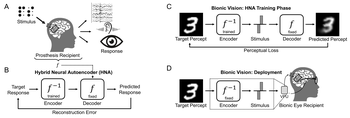What is the required stimulus to produce a desired percept? Here we frame this as an end-to-end optimization problem, where a deep neural network encoder is trained to invert a known, fixed forward model that approximates the underlying biological system.
A neural autoencoder to enhance sensory neuroprostheses
“We started working on this project in an attempt to solve the long-standing problem of stimulus optimization in visual prostheses,” Jacob Granley, one of the researchers who carried out the study, told TechXplore. “One of the likely causes for the poor results achieved by visual prostheses is the naive stimulus encoding strategy that devices conventionally use. Previous works have suggested encoding strategies, but many are unrealistic, and none have given a general solution that could work across implants and patients.”
Read the full article at techxplore.com.
The paper has been accepted at NeurIPS ‘22.

Publications
Hybrid neural autoencoders for stimulus encoding in visual and other sensory neuroprostheses
Jacob Granley, Lucas Relic, Michael Beyeler 36th Conference on Neural Information Processing Systems (NeurIPS) ‘22
